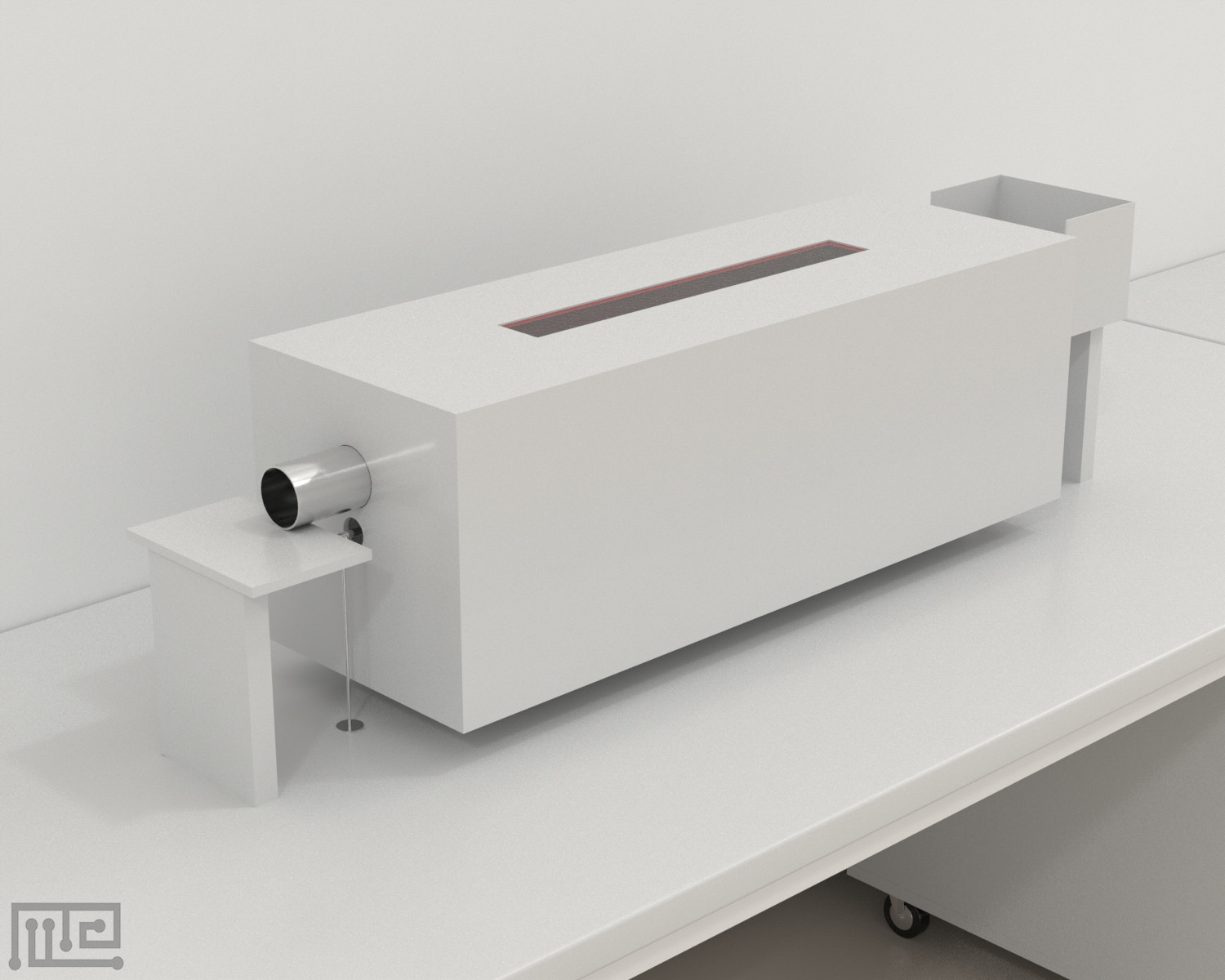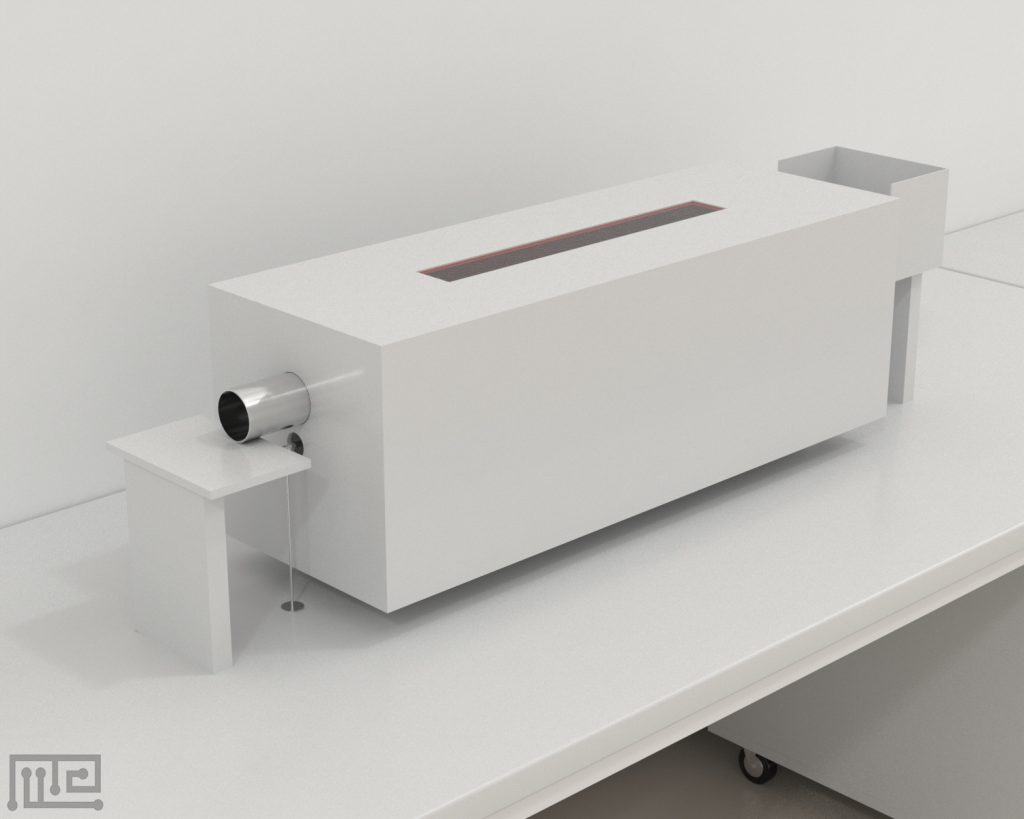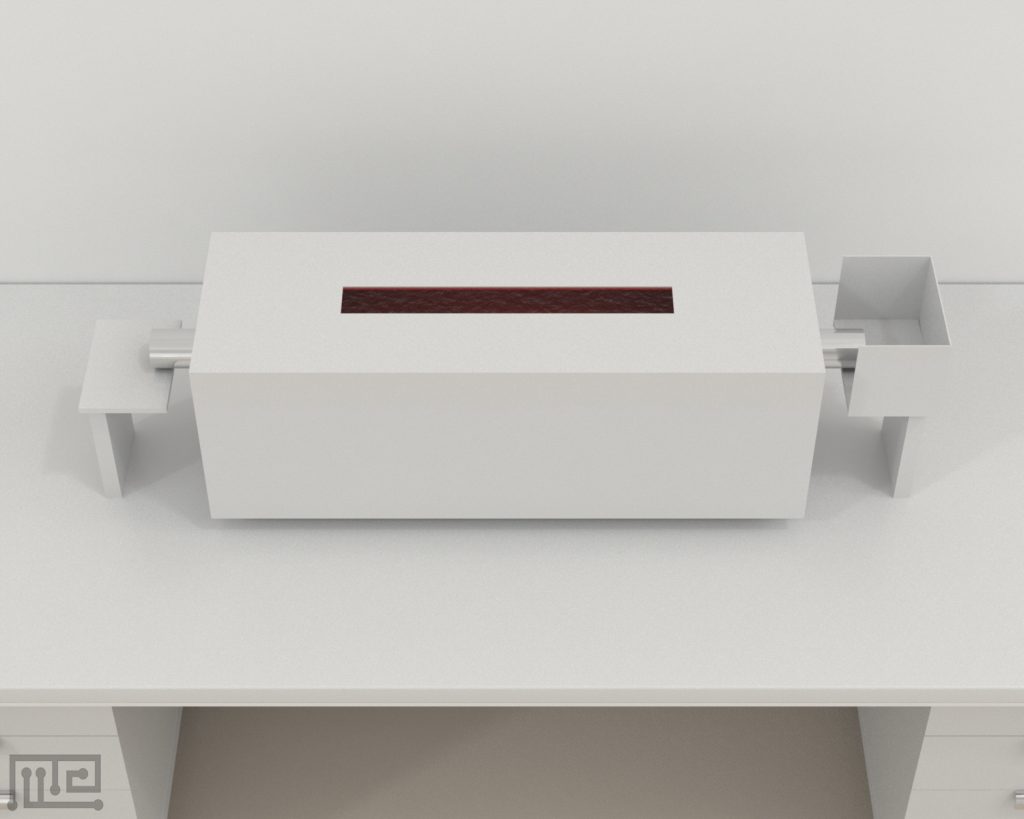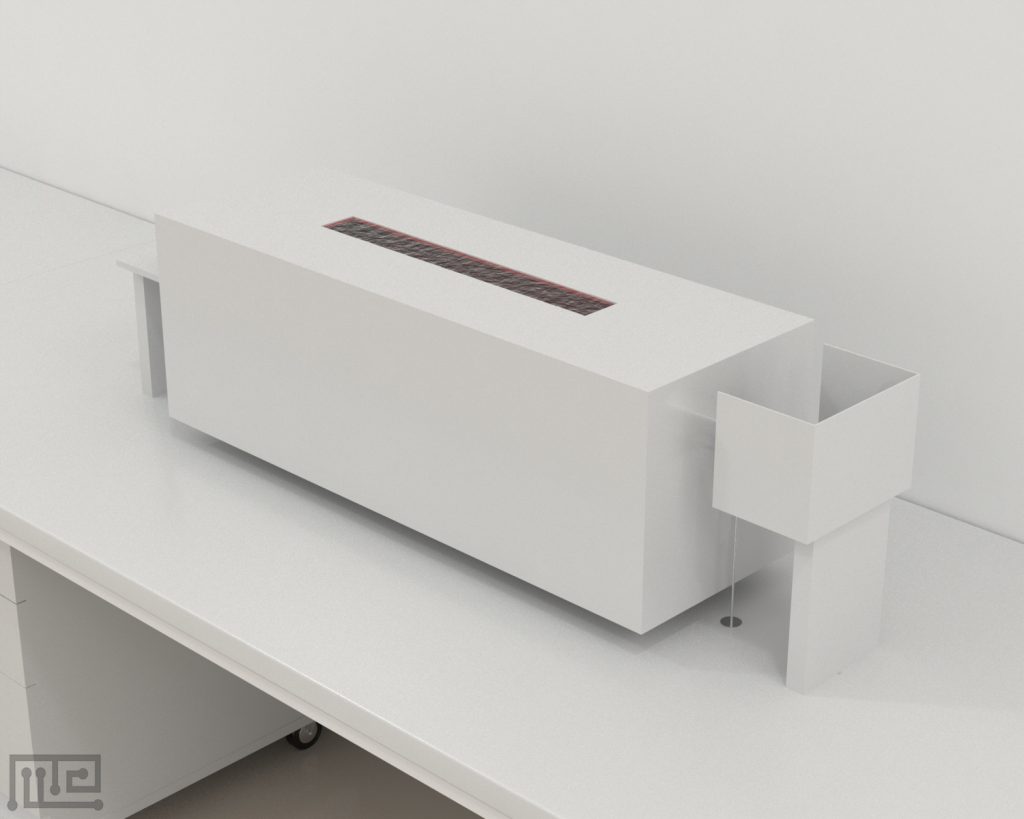The Rodent Tilt Apparatus was used by Bernard F. Riess et al. (1950), to assess the relationship between the tilt of a visual field and the deviation of body position from the vertical in rats.
It is an enclosed rectangular acrylic box with a hole drilled through the center of each end piece. Just above each of these center holes, a tin can, opened at both ends, is extended for ½in. through an opening into the chamber. One of these cans was the entrance tube and the other an exit tube. Just adjacent to these and outside the main box were acrylic starting and feeding platforms. The latter served as the goal box where food was obtained after each run and was enclosed on three sides by upright cardboard walls.
- a—starting platform
- b—side of visual chamber
- c—bottom of chamber
- d—entrance tube
- e—light bulb
- f—tinted cellophane panel
- g—dowel stick pathway

- h—end piece (exterior)
- i—exit tube
- j—pathway support
- k—table
- 1—rod
- m—stylus
- n—feeding platform
Price & Dimensions
Mouse
$ 1890
+S&H- Length of rectangular acrylic box: 24in
- Width of rectangular acrylic box: 8in
- Height of rectangular acrylic box: 8in
- Diameter of hole at end piece: 1¼in
- Tin can: 2½
Rat
$ 1990
+S&H- Length of rectangular acrylic box: 36in
- Width of rectangular acrylic box: 12in
- Height of rectangular acrylic box: 12in
- Diameter of hole at end piece: 1¼in
- Tin can: 2½
Documentation
Introduction
The Rodent Tilt Apparatus consists of a rectangular acrylic box that is suspended in the air. It can be rotated to different degrees of rotation in either left or right directions. It is used to observe whether a rodent’s body position deviates from the vertical position depending on the tilt of their visual field. Other apparatuses that focus on the visual system, such as the Visual Water Box or the Y-maze, solely focus on the visual discrimination abilities of rodents. The Rodent Tilt Apparatus, however, also focuses on other sensory modalities such as kinesthetic, labyrinthine, and tactile senses in conjunction with the visual system.
The Rodent Tilt Apparatus contains a path that connects the starting platform to the goal box. As the subject walks on the path, it shifts its weight to either right or left side. This motion is registered on a kymograph drum through a stylus that is connected to the cross-bar of the apparatus. The top and bottom lines of the graph portray deviation to the right or left from the vertical position. Since the apparatus can easily be rotated, the subjects can be tested at any degree of rotation depending on experimental needs.
Other apparatuses used to study rodent behavior include the Balance Beam, the T-Maze, and the Elevated Plus Maze.
Apparatus and Equipment
The Rodent Tilt Apparatus consists of a rectangular acrylic box that measures 36 x 12 x 12 inches. A hole of 1½ inches in diameter is drilled through the center of each end piece of the box. Above each of these center holes, a 2½ inch tin can that is opened at both ends extends for ½ an inch through an opening into the chamber. One of these cans serves as the entrance while the other serves as the exit tube. Outside the main box, adjacent to the tin cans, two platforms are placed. One platform serves as the starting platform, and the other serves as the feeding platform. The feeding platform, which is also the goal box, is enclosed on three sides by upright cardboard walls. The end pieces of the box are painted diagonally, with the top and bottom forming four triangles with their apices meeting at the center holes in the end. The triangles whose bases are continuous with the bottom of the box are painted black, and the triangles that are continuous with the sides are painted white. On the center of the top cover of the chamber, a 4-inch wide dark, tinted cellophane sheet is placed to eliminate outside illumination. The internal illumination is provided through four flashing bulbs placed on each side of the inside portion of the top of the chamber. Wires attached to overhead braces help suspend the apparatus and allow it to be rotated independently of the path bar. The path is made up of a wooden dowel that is 4 feet long and ¾ inch in diameter. The path runs through the center holes in the end pieces and is suspended at each end in metal, V-cut, pivots fastened to upright supports. At the entrance tube, a spring is stretched from the path to the table that provides a certain amount of tension and allows the path to return to its normal position after displacement. The path protrudes at the exit of the box and has a 12-inch metal rod inserted through its center at a right angle to it. The motion of the subjects is registered on a kymograph drum through a stylus on the cross-bar. The bottom panel of the apparatus is placed on hinges, which allow easy removal of the subjects if they fall from the path.
Training Protocol
Clean the apparatus after every trial. A tracking and recording system such as the Noldus Ethovision XT can be used to assist with observations.
Habituation and Pre-training
Keep the apparatus at 0° tilt and the bar free from rotating. Place the subjects in the starting platform and allow them to familiarize themselves with the path. Conduct 10 trials in which five trials are free from pausing the subjects’ midway on the bar.
Rodent Tilt Apparatus Task
Tilt the apparatus to the left or right at 0°, 10°, 20°, or 30° from the vertical. Place a subject on the starting platform and allow it to reach the goal box. Allow the subject to eat the reward until a baseline for the next recording on the kymograph is prepared. Remove the subject from the apparatus and place it in on the starting platform for the next trial. Perform four trials per subject for each tilt situation with the first and last set of trials being at 0° tilt.
Literature Review
Investigation of a potential relationship between the tilt of a visual field and the deviation of body position from the vertical in white rats.
Riess, Kratka, and Dinnerstein (1950) investigated whether there was a relationship between the tilt of a visual field and the deviation of body position from vertical in rats. The experiment was conducted on the rodent tilt apparatus on ten albino rats (five males and two females) of C-3 strain that were 120 days old and three female Sprague-Dawley rats (170 days old). The subjects were divided into male and female groups and were required to perform ten habituation sessions on the apparatus. The training was then performed where the apparatus was tilted to the left or right at 0°, 10°, 20°, or 30° from the vertical position across four consecutive trials. The order of degrees was randomly assigned to the males and repeated in the female groups. The subject’s motion was recorded on a kymograph. A greater deviation in body position from the vertical caused the graph line to deviate further from the baseline. The results indicated no significant difference between deviating tendency under left and right tilt conditions at all degrees of rotation except 10°. At 10°, the difference in behavior in the right tilt against the left tilt was significant at 0.1. Furthermore, as trials progressed, a decrease in body dislocation from the vertical was observed. No significant differences were observed between the male and female groups for any degree of visual field dislocation.
Data Analysis
The following can be observed using the Rodent Tilt Apparatus:
- Deviation of the subject’s body position from the vertical
- Right tilt deviating tendency
- Left tight deviating tendency
Strengths and Limitations
Strengths
The Rodent Tilt Apparatus is used to study the relationship between the tilt of the visual field of rodents and their body position. Apart from the visual system, it also focuses on kinesthetic and labyrinthine sensory modalities. The apparatus can be tilted on any degree of rotation depending on experimental needs. Trials can be performed in a short amount of time.
Limitations
The presence of unnecessary stimuli may affect the way the subject performs the task. Task performance may be influenced by age, gender, and strain of the subject. The exploratory drive of the subjects is necessary for the completion of the task.
Summary
- The Rodent Tilt Apparatus is used to observe the relationship between the tilt of the visual field and deviation of body position from the vertical in rodents.
- It consists of a rectangular acrylic box that is suspended in air and can be rotated in either left or right directions to different degrees of rotation.
- Inside the apparatus, a path is present that connects the starting platform to the goal box.
- A kymograph drum records the subject’s motion as it walks to the left or right of the path.
References
Riess, B. F., Kratka, H., & Dinnerstein, A. (1950). The relationship between the tilt of a visual field and the deviation of body position from the vertical in the white rat. Journal of experimental psychology, 40(4), 531. DOI:10.1037/h0056063
Request a quote
"*" indicates required fields




